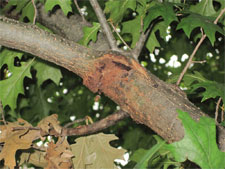Question and Answer – November 2010
If you’d like Neil’s help with your plant question, send it AND a photo to go with it to Neil. Click here to do so. He chooses those questions of greatest general reader interest (no plant IDs, please) and addresses them right here the following month.
Note from Neil: This is a good time of year to send me your question. Things lighten up now, as you can tell from the smaller number of questions below. Lots of tree questions this time around.
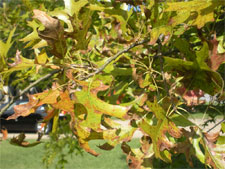
Question: We are in the Casa Linda area near White Rock Lake (shallow soils). This red oak was in the center of our yard when we bought our home. I’ve been caring for it for several years, and I thought it was responding. However, now its leaves are a sickly yellowish-green, and it appears to be going downhill. I water it carefully, and I don’t use a weedkiller on my lawn. What is going wrong? Has sunscald finally killed it? J.D., East Dallas.
Answer: The branch structure of your tree looks more like pin oak (Quercus palustris). That’s a tree that requires acidic soils of the northeastern United States. It sometimes gets sold in Texas nurseries, mistaken for the better-adapted Shumard red oak (Q. shumardii). If it’s a pin oak, the iron deficiency and its associated yellowing and leaf burn will only get worse. However, I will confess that the leaves I can see in your photo do look like they could be from a Shumard red oak (they are extremely similar to those from pin oaks). If that’s the case, there may be trunk damage of some sort. Check that possibility. You might want to invest in a visit by a certified arborist to be more certain of the answer.
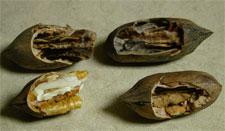
Question: Most of my pecans cannot be eaten. A few, like those in the front of my photo, are good. But, the vast majority have meat that is withered and brown. I see no evidence of insect holes in the shells, and the tree itself is healthy. Any idea of the cause? J.B., Abilene.
Answer: My family lives on the floor of a pecan forest. The initial answer I was drafting left a couple of possible options, so once again, I decided to call in a pro. John Begnaud is a 40-year friend who retired just a couple of years ago after a career as County Horticulturist in Tom Green County, Texas (San Angelo – close to you). He writes for our magazine and often consults at our landscape school. No one knows pecans any better. Here are his suggestions for your pecans: (Thanks, John!)
Pictures typify nuts from overloaded, older trees. Lots of wafers! Early season pollination and pops, also if isolated tree.
Pecan kernel quality is affected by many factors, including variety, crop load, diseases such as pecan scab, insects such as hickory shuckworm and age and condition of the tree. These samples contain wafers or poorly filled kernels which is an indication of overproduction. Overcropping will also have a big influence on ripening, shucksplit and can cause sticktights with delayed nut drop. Even when properly fertilized and watered, pecan trees can be unable to assemble enough food to fill too many nuts. Make sure you follow local guidelines for fertilizer, zinc sprays and timely irrigations to improve kernel quality and better crops will come.
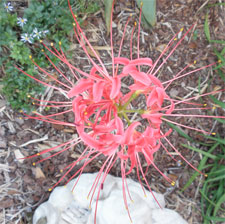
Question: I found this flower growing in a wooded area at the golf course two years ago. I transplanted it to my flowerbed, but it doesn’t multiply. What can I do to get it to spread? J.F., Garland.
Answer: That’s spider lily, Lycoris radiata. Someone probably planted it on the course years ago, or it might have been brought in with soil from another site. It’s a cultivated perennial flower that blooms every fall. It will multiply slowly. If you want more, you really ought to just buy several dozen of the bulbs when they are available in nurseries late next summer. It’s a great plant!
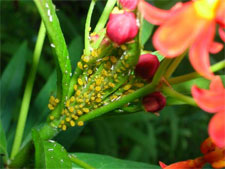
Question: A month ago, I noticed many bright yellow ovals on my milkweed stems. Thinking they were aphids, I looked for ants, but I didn’t see any. Should I remove the stalks? M.P., Bedford.
Answer: These are indeed aphids. The species that colonizes on milkweeds is among the most colorful of all aphids. Honestly, if you want milkweeds to feed other insects that would visit your garden, you’re probably going to have these aphids every year, too. They’re of no special concern. Follow your heart on what you do. They will not spread to other non-milkweed plants.
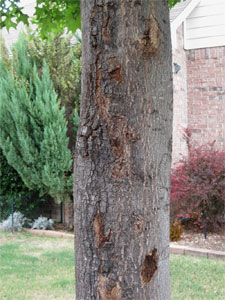
Question: Please advise what might be wrong with our oak tree. This is its fifth year in our landscape. It was bought from a local tree nursery, and although it’s still looking healthy, I’m concerned about it. M.K., Richardson.
Answer: Because the damage showing on your oak’s trunk is aligned vertically, I really suspected sunscald. However, I wanted to get a second opinion from the man who looks at more oak trees in a week than I’ll see in a lifetime. Steve Houser and one of his teams from Arborilogical Services were working at our house yesterday. I asked him to help with your question. Here is what he wrote for you: (Thanks, Steve!)
Both the trunk and limb wounds appear to be older injuries that are now starting to show the damage as the typical bark pattern is disrupted. The limb wound appears to be from a carpenter worm (a type of boring insect) due to the sunken area in the bark and the callous tissue (or wound wood) formation around the wound. Being an old wound, the insect is likely to be long gone and no longer a concern. The carpenter worm is typically a solitary feeder.
If the trunk wound is on the south or west side of the red oak, it was likely to be caused by sunscald. Trees grown in the shade and moved into full sun often develop sunscald because the trunk tissue has not yet adapted to the sunny conditions. Since the wound is completely healed in many areas, an ongoing maintenance program should help the tree adapt to the new conditions.
If any species of tree is not well adapted to our soil, it will often show yellowing foliage and not survive in the long term. This underscores the need to use a reputable supplier that is knowledgeable about the various species of trees.


